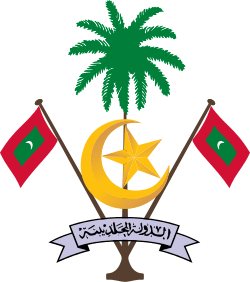Women in the Maldives
 A Maldivian bride. | |
| Gender Inequality Index | |
|---|---|
| Value | 0.357 (2012) |
| Rank | 64th |
| Maternal mortality (per 100,000) | 60 (2010) |
| Women in parliament | 6.5% (2012) |
| Females over 25 with secondary education | 20.7% (2010) |
| Women in labour force | 55.7% (2011) |
| Global Gender Gap Index[1] | |
| Value | 0.6604 (2013) |
| Rank | 97th out of 136 |
The status of Women in the Maldives has traditionally been fairly high, as attested to in part by the existence of four Sultanas. Women do not veil, nor are they strictly secluded, but special sections are reserved for women in public places, such as stadiums and mosques. Women do not accept their husbands' names after marriage but maintain their maiden names. Inheritance of property is through both males and females.
As Muslims, men may have as many as four wives, but there is little evidence to suggest that many have more than one.
Women have always had an important role in the family and community. In the early history of Maldives, it was not uncommon to have a woman as a Sultana or ruler and it has been suggested that the society was once a matriarchy.
In today’s society women hold strong positions in government and business. A large percentage of government employees are women. The male female ratio of enrollment and completion of education to secondary school standards remains equivalent. Women serve in the cabinet and the Parliament.
In 2013, a 15 year-old rape victim received a sentence of 100 lashes for fornication. The sentence was later overturned by the Maldivian High Court, following an international petition campaign led by Avaaz.[2]
References
- ↑ "The Global Gender Gap Report 2013" (PDF). World Economic Forum. pp. 12–13.
- ↑ "Maldives rape victim spared the lash after global anger". The Independent. 2013-08-24.
![]() This article incorporates public domain material from websites or documents of the Library of Congress Country Studies.
This article incorporates public domain material from websites or documents of the Library of Congress Country Studies.
External links
| Wikimedia Commons has media related to Women of the Maldives. |
| ||||||||||||||
| |||||||||||||||||||||||||||||||||||||

